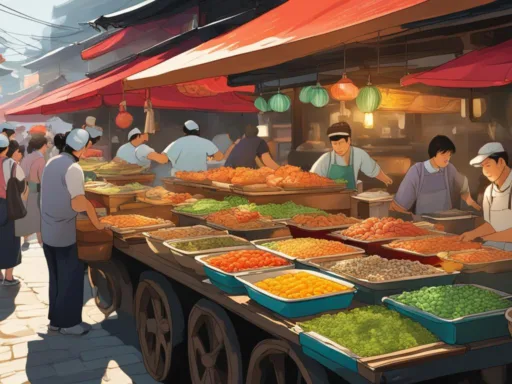Imagine embarking on a culinary journey so diverse and rich that it tantalizes your tastebuds with the very soul of Africa. Think of a world where every dish holds a tale and every flavor a deep-rooted history. This is the taste of Zimbabwe—an exquisite and hearty experience of Zimbabwean flavors that’s often overlooked on the global gastronomic map. As you set foot into this flavorful odyssey, let us guide you through a realm where Zimbabwean food culture is just waiting to be discovered—one vibrant plate at a time. From historical roots to a touch of modern flair, sink your teeth into the uncharted territories of Zimbabwean Culinary Discoveries.
Key Takeaways
- Unveil the vibrancy and variety of traditional and contemporary Zimbabwean dishes.
- Learn the significance of maize as it shapes the nutritional, cultural, and historical landscape of Zimbabwe.
- Experience the profound cultural heritage behind each dish, reflecting Zimbabwe’s rich history and flavors.
- Embark on an exploration that highlights innovative chefs bringing new twists to authentic Zimbabwean meals.
- Discover how local ingredients and traditional cooking practices come together, offering a unique culinary adventure.
- Gain insights into the best dining spots across Zimbabwe to satisfy cravings for true Zimbabwean gastronomy.
Zimbabwean Culinary Discoveries: An Introduction to Unique Flavors and Traditions
Embark on a tantalizing journey through the rich tapestry of traditional Zimbabwean dishes that are not just meals, but narrate the history and collective spirit of a nation. The story of authentic Zimbabwean cuisine is one of diverse influences; a cuisine steeped in tradition yet constantly evolving with the passage of time. This exploration is an invitation to discover and cherish the distinct and Zimbabwean culinary discoveries that have carved a unique niche on Africa’s gustatory map.
- Delight in the symphony of flavors presented by dishes like Sadza, a beloved staple made from maize and often accompanied by savory stews.
- Experience the harmonious blend of textures and tastes in Muriwo Unedovi, a traditional dish that combines leafy greens with rich, creamy peanut butter.
- Tantalize your taste buds with the zesty and fiery kick of Chakalaka, a spicy vegetable relish that elevates any meal.
Zimbabwe’s culinary identity is a reflection of its bountiful natural resources, interwoven with local customs and communal celebrations. Ingredients sourced from the land such as millet, sorghum, and the indigenous mopane worms, grant unique characteristics to the country’s food palette. Revel in the culinary heritage where every ingredient is a tribute to the earth and every dish, a celebration of life.
Whether it’s through the hands of a time-honored village cook or the innovative techniques of city chefs, every helping of Zimbabwean fare tells a story. Join us as we delve deeper into the essence of this vibrant cuisine, unlocking the secrets of its longstanding allure and appeal.
The Roots of Zimbabwean Food Culture: A Historical Perspective
The rich tapestry of Zimbabwean food culture is a colorful blend of taste, tradition, and history. This segment delves into the intricacies of traditional Zimbabwean dishes and their evolution, highlighting the impact of various influences on Zimbabwe’s gastronomic legacy. As we unearth the historical roots of Zimbabwean cuisine, join us in appreciating how dishes that originated long ago continue to nourish and define a nation.
The Evolution of Traditional Zimbabwean Dishes
Zimbabwe’s culinary evolution can be traced back through a lineage of flavors and techniques that echo the past. From robust meat stews to diverse vegetarian fare, traditional recipes have been shaped by local resources, societal changes, and colonial influences. The synchronization of indigenous food practices with those introduced from other cultures has led to the creation of unique and defining dishes that are now quintessential to the Zimbabwean dining experience.

One cannot discuss Zimbabwean food culture without recognizing the role of community gatherings and ceremonies in shaping today’s culinary practices. Feasts and social events have traditionally been avenues for the transmission of cooking knowledge. A look into these recipes not only feeds the stomach but also offers insight into the country’s soul.
Significance of Maize in Zimbabwean Cuisine
In discussing the foundations of the country’s cuisine, maize holds a prominent place. Central to the Zimbabwean diet is Sadza, a versatile maize-based food that resonates with the Zimbabwean ethos of simplicity and sustenance. The prevalence of maize in traditional dishes can be attributed to its adaptability and availability, making it a staple not just in homes but also in the nation’s agricultural and economic sectors.
| Traditional Dish | Main Ingredients | Cultural Significance |
|---|---|---|
| Sadza | Ground maize, water | Staple food, symbolizes unity and family |
| Nhedzi | Wild mushrooms, onions, tomatoes | Connected to foraging traditions and rainy season |
| Dovi | Peanut butter, vegetables, meat or fish | Embodies resourcefulness, reflects trade, and culinary influences |
Exploring Zimbabwean dishes is akin to traveling through time, each meal presenting a story of the land, its people, and their journey. Engaging with traditional Zimbabwean dishes gives us a taste not only of robust flavors but also of resilience and the transformative power of historical and cultural melding.
Exploring Traditional Zimbabwean Dishes and Their Significance
The tapestry of Zimbabwean food culture is woven with the lasting threads of traditional Zimbabwean dishes. Each dish tells a story—a narrative of community, survival, and celebration. Here, we embark on a culinary journey through the quintessential flavors and underlying meaning of authentic Zimbabwean cuisine.
In the heart of Zimbabwe, the harmony of rich, nutrient-packed gardens and the bounty of assorted livestock culminate in dishes that reflect the land’s fertility and wealth. Vegetable-based meals are not merely a dietary staple but a lavish spread of vitamins and flavors, as epitomized by Muriwo Unedovi, a traditional dish comprising dark leafy greens smothered in a creamy peanut butter sauce.
Protein is celebrated too, with Nyama—meat that is typically grilled or stewed—playing a pivotal role in communal feasts and everyday meals alike. Zimbabwe’s culinary offerings are diverse, emanating from different regions and influenced by the seasons, yet they all symbolize a unifying factor: a sense of belonging and shared history.
In Zimbabwe, food is more than sustenance; it is the essence of family, community, and identity.
Below, we have outlined some of the core traditional dishes and their inherent symbolism within Zimbabwe’s vibrant cultural mosaic.
| Dish | Main Ingredients | Cultural Significance |
|---|---|---|
| Sadza | Ground maize meal | Staple food signifying unity; often shared from a communal bowl. |
| Muriwo Unedovi | Greens, peanut butter | Represents health and vitality; reflects the use of locally grown produce. |
| Nyama | Beef, goat, chicken | Serves as a celebratory dish; signifies abundance and prosperity. |
| Huku neDovi | Chicken, peanut butter sauce | A fusion of flavors; illustrates inventive use of common ingredients. |
The cultural import of these delicacies is deeply ingrained in the country’s spirit. Zimbabwe’s culinary profile is a testament to its resilience, ingenuity, and undying appreciation for the land’s gifts. A meal here is never just about sating hunger—it’s about preserving a heritage and partaking in the countless stories these flavors carry. To truly understand Zimbabwe, one must taste its authentic dishes and decode the tales they tell.
Popular Zimbabwean Recipes: A Taste of the Culture
A gastronomical journey through Zimbabwe is incomplete without sampling some of its most beloved dishes. At the heart of the country’s rich culinary identity lies popular Zimbabwean recipes that not only provide sublime flavors but also carry cultural narratives passed down through generations. Let’s delve into the staples that embody the taste of Zimbabwe, highlighting the comforting presence of Sadza and the verdant allure of Muriwo Unedovi.
Sadza: The Quintessential Zimbabwean Staple
Often referred to as the backbone of Zimbabwean cuisine, Sadza is a versatile and essential staple at most meals. This maize-based delight is akin to a thickened porridge, enjoyed for its neutral taste and ability to complement an array of dishes. Owing to its fundamental role in the Zimbabwean diet, Sadza has become synonymous with the country’s culinary practices and is cherished in households nationwide.

Muriwo Unedovi and the Richness of Zimbabwean Greens
Zimbabwean cuisine is gifted with Muriwo Unedovi, a lush, flavorful vegetable dish made predominantly with collard greens or spinach. This dish is elevated into a creamy, nutty treat through the addition of peanut butter, testament to Zimbabwe’s proclivity for harmonizing greens with distinct, rich tastes.
| Ingredient | Sadza | Muriwo Unedovi |
|---|---|---|
| Main Base | Maize Meal | Collard Greens/Spinach |
| Culinary Use | Staple, Accompanies Meats/Vegetables | Veggie Main Course or Side |
| Texture | Porridge-like, Thick | Leafy, Creamy with Peanut Butter |
| Cultural Significance | Symbol of Nourishment and Unity | Reflection of Zimbabwe’s Veggie Cuisine |
Tradition and creativity come together in these quintessential dishes, providing a glimpse into the domestic hearts of Zimbabwe where families gather to share a meal. Through dishes like Sadza and Muriwo Unedovi, we not only savor the taste of Zimbabwe but also engage with its vibrant culture, steeped in history and communal joy.
Authentic Zimbabwean Cuisine: From Mopane Worms to Kapenta
Embark on an exploration of the rich and diverse flavors of authentic Zimbabwean cuisine, where traditional cooking meets a bounty of unique Zimbabwean ingredients. Known for its vibrant taste and nutritional value, the food of Zimbabwe offers an intriguing blend of dishes that engage all the senses. One of the most fascinating aspects of this cuisine is how it has embraced indigenous foods like Mopane Worms and Kapenta, showcasing an unyielding respect for the natural environment from which these ingredients are sourced.
Highlighting Local Ingredients and Preparation Methods
The use of local ingredients such as Mopane Worms and Kapenta reflects the resourcefulness and ingenuity of Zimbabwean cuisine. Mopane Worms, harvested from the Mopane tree and either dried or smoked, are a protein-packed choice that is as sustainable as it is delicious. Meanwhile, Kapenta, a type of small, sardine-like fish from Lake Kariba, is often dried and offers a salty crunch when fried. The traditional preparation methods for these foods are as distinctive as the flavors they present, with each dish evoking a sense of place and tradition.
Unveiling the Delicacy of Mopane Worms
The culinary practice of eating Mopane Worms might seem unconventional to the uninitiated, but for many in Zimbabwe, it’s a delicacy that’s both nutritional and cultural. These caterpillars, once cleaned and cooked, are known for their meaty texture and ability to absorb the flavors of the spices and ingredients they’re cooked with. Often served in a tomato-based sauce or simply sautéed with onions, garlic, and chili, Mopane Worms truly are a testament to the inventive and bold spirit of Zimbabwe’s culinary heritage.

Whether you’re a daring foodie or a culinary conservative, giving consideration to these unique aspects of Zimbabwean cuisine could add an exotic twist to your dining experience. By indulging in these specialties, you partake in a centuries-old tradition that carries the essence of Zimbabwe’s bountiful lands and resourceful people. The next time you come across a dish featuring Mopane Worms or Kapenta, remember that you’re not just trying something new; you’re savoring a piece of authentic Zimbabwean culinary artistry.
Zimbabwean Flavors: The Perfect Fusion of Spices and Techniques
The vibrant tapestry of Zimbabwean flavors is interwoven with the skilled use of traditional Zimbabwean spices and intricate culinary techniques in Zimbabwe. These elements blend seamlessly to create tastes that are as rich in history as they are in flavor. For gourmands and culinary enthusiasts alike, Zimbabwe’s gastronomic landscape offers a multi-sensory experience with each meticulously prepared dish.
An essential aspect of the magic behind Zimbabwean cuisine lies in the subtle balance and variety of its spice palette. One cannot help but be enchanted by dishes like the legendary Chakalaka, a spice-infused relish that serves as a fiery testament to the vibrant spirit of Zimbabwean cooking.
| Spice | Flavor Profile | Dish |
|---|---|---|
| Pepper | Pungent, sharp | Stews and Soups |
| Cinnamon | Sweet, woody | Desserts and Porridge |
| Peanut Butter | Rich, creamy | Peanut Butter Stew |
| Chili | Intense, hot | Chakalaka Relish |
As we delve deeper into the tradition, we find that these flavors arise from more than just spice; it’s the distinct culinary techniques in Zimbabwe that foster their depth. The slow simmering of stews, the grilling of meats over open flames, and the artful fashioning of grain into nourishing staples, are all a testament to Zimbabwe’s culinary ingenuity.
Zimbabwe’s cooking artistry shines through in dishes that tell a story, a culinary narrative that speaks to both the nation’s past and its persistent push for gastronomic innovation.
- Roasting and smoking meats for tender textures.
- Grinding peanuts into a fine paste for enriching sauces and stews.
- Utilizing seasonal produce to create sustainable and flavorsome meals.
The profound appreciation for traditional methods combined with a resourcefulness in the kitchen ensures that Zimbabwean dishes are not only an exploration of taste but also reflective of the nation’s ethos and identity.
Dining Out: Best Restaurants in Zimbabwe for Local Delights
Zimbabwe’s culinary landscape is a marvel for gastronomes looking to experience authentic Zimbabwean dishes. The journey to uncover the tastiest treats leads to a myriad of local Zimbabwean eateries and some of the best restaurants in Zimbabwe, where one can indulge in both time-tested recipes and innovatively crafted cuisine that tells the story of this vibrant nation.
Finding the Heart of Zimbabwean Cuisine in Local Eateries
True food enthusiasts understand that to grasp the essentials of Zimbabwean cuisine, one must venture into the bustling local eateries. These spots are not just about eating; they are experiences that engage all senses, offering a slice of the cultural fabric through every bite. Here’s a curated list of local favorites that are a must-visit.
- Bulawayo’s “Indaba Book Café” – A cultural hub that serves local dishes with a modern twist
- Harare’s “Gava’s” – Famous for its impeccable sadza and flame-grilled meat
- Victoria Falls’ “Mama Africa Eating House” – Known for its diverse menu featuring game meat and traditional stews
Culinary Hotspots: Where to Experience Authentic Zimbabwean Dishes
When on the hunt for culinary excellence, one should look for hotspots that are renowned for their authentic take on Zimbabwean delicacies. Below is a table highlighting restaurants that have perfected the art of serving up Zimbabwe’s most beloved dishes.
| Restaurant | Location | Recommended Dish |
|---|---|---|
| Amanzi Restaurant | Harare | Mopane Worms |
| The Boma – Dinner & Drum Show | Victoria Falls | Game Meats and Traditional Dancing Experience |
| La Fontaine Grillhouse | Harare | Zimbabwean Beef Fillet |
From Harare’s classy dining establishments to the adventurous menus of Victoria Falls, these culinary institutions provide not just meals, but escapades that celebrate the essence of Zimbabwe’s taste palette. Whether it’s in the artful ambiance of a high-end restaurant or the warm, welcoming air of a street-side cafe, Zimbabwe’s food scene is rich with opportunity for those seeking to sate their hunger with genuine local flavors.
A Zimbabwean Culinary Renaissance: The Modern Twist on Classics
The realm of Zimbabwean cuisine is experiencing a vibrant and creative transformation that signifies a new era for the country’s food culture. This change is led by a cadre of contemporary Zimbabwean chefs who are infusing beloved traditional recipes with modern savoir-faire. These culinary artists are arming themselves with the freshest local produce, adhering to farm-to-table practices to bring forth dishes that are endorsing a new wave of gastronomical identity in Zimbabwe.
Contemporary Chefs Innovating Traditional Fare
There is a growing trend among chefs to revisit the classics of Zimbabwean cuisine, breathing new life into them with inventive presentations and complex flavor profiles. This movement isn’t merely about modernization, but importantly about honoring and elevating the heritage by keeping the essence of the dish intact while providing a modern twist on classics.
One finds Sadza in innovative formats, paired with contemporary sauces or used as a base for new creations, while still retaining the comforting texture and role it traditionally plays. In the hands of these culinary innovators, a rebirth is taking place; the untold stories of Zimbabwean flavors are being rewritten through a lens that values both authenticity and modernity.
From Farm-to-Table: The New Zimbabwean Culinary Scene
The infusion of farm-to-table practices in Zimbabwe is not only promoting sustainability but also ensuring the flavors are as pure and resonant as possible. The nexus between the farmer’s toils and the chef’s creations exemplifies a symbiotic relationship that’s at the core of Zimbabwe’s culinary renaissance. Celebrated dining experiences across Zimbabwe now beam with pride in showcasing menus that feature hyper-local ingredients, conjuring a truly Zimbabwean narrative on every plate.
The farm-to-table approach reinforces the integrity of the food and affirms the Zimbabwean commitment to culinary excellence. With each dish, contemporary chefs articulate a story – one where the journey from the soil to the plate is as important as the flavors that ensue. It’s an approach that harmonizes traditional wisdom with the requisites of modern dining, constructing a bridge between the past and the present that guests are eager to traverse.
In this culinary resurgence, the essence of Zimbabwe’s landscape, its people, and its traditions emerge more powerfully than ever through dishes that are rooted in the locale but expressed with a fresh perspective. This is the gastronomical landscape where every ingredient has a provenance, and every dish has a tale – tales born of the land and served with zest by the visionary contemporary Zimbabwean chefs spearheading the revolution.
Conclusion
As our journey through the flavorsome realms of Zimbabwean cuisine draws to a close, we embrace the intricate dance between the past and present influencing this nation’s food. Every dish we’ve encountered is a testament to the resilience and vibrancy of Zimbabwean culture, beautifully conveying how food not only sustains but enriches our collective heritage. It’s clear that preserving Zimbabwean tradition doesn’t mean forsaking progress—it means evolving with reverence and respect for the customs and ingredients that have long shaped this cuisine into what it is today.
Preserving Tradition While Embracing Innovation
In a world keenly tuned into the new and novel, Zimbabwe presents a stunning example of how to weave the new threads of culinary innovation into the enduring tapestry of its gastronomic identity. Chefs and home cooks alike continue to honor classic flavors while injecting contemporary techniques that speak to a global palate. By fostering this culinary duality, Zimbabwe’s food narrative remains relevant and exciting, testament to a culture that honors its foundation while reaching for new heights of flavor and presentation.
Embracing the Taste of Zimbabwe at Home with a Classic Recipe
For those aspiring to experience the authentic taste of Zimbabwe without leaving their kitchens, the iconic Zimbabwean beef stew with Sadza offers a warm invitation to try your hand at this culinary craft. This beloved dish is steeped in the traditions of the nation, combining tender, savory beef with the staple goodness of Sadza, bringing the essence of Zimbabwean hospitality right onto your dining table. It serves not just a meal but a delicious reminder of Zimbabwe’s rich culinary legacy for anyone eager to indulge in genuine and heartwarming fare.
FAQ
What are some traditional Zimbabwean dishes that offer a taste of the nation’s culinary culture?
How has the historical roots of Zimbabwean cuisine influenced modern dining experiences?
Why is maize such an important ingredient in Zimbabwean cuisine?
What makes Sadza a quintessential part of Zimbabwean meals?
Can you find traditional Zimbabwean flavors in today’s restaurants?
What unique Zimbabwean ingredients should food explorers try?
How are local chefs contributing to the contemporary Zimbabwean culinary scene?
Where can I find the best restaurants to experience authentic Zimbabwean dishes?
Source Links
- https://strawpoll.com/most-popular-food-zimbabwe
- https://medium.com/@scribblesandnibbles/culinary-journey-through-zimbabwe-a-4-part-series-unveiling-tradition-with-a-modern-twist-038a7574a24e
- https://scribblesandnibbles.medium.com/part-4-a-culinary-renaissance-in-zimbabwe-blending-tradition-and-innovation-e08f5eff2668?source=rss——culture-5






